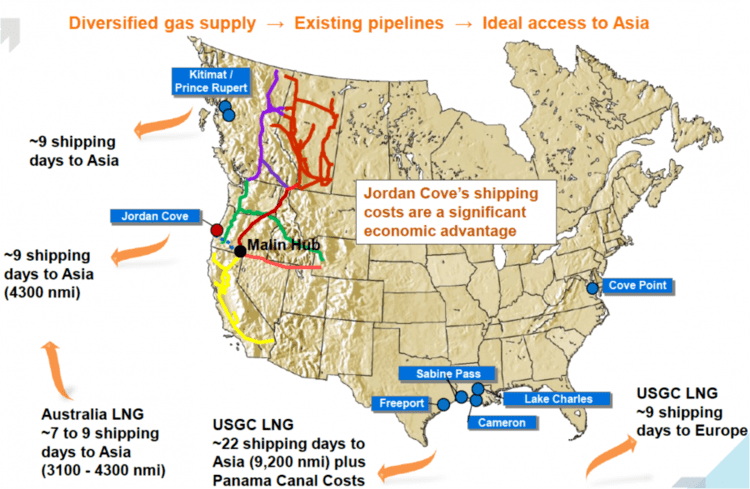 | ||
The Jordan Cove Energy Project is a proposal by Calgary-based energy company Veresen to build a liquefied natural gas export terminal within the International Port of Coos Bay, Oregon. The natural gas would be transported to the terminal by the Pacific Connector Gas Pipeline.
Contents
Map of Jordan Cove, Oregon, USA
Facility
The site proposed for the Jordan Cove Energy Project is located on property controlled by the International Port of Coos Bay, which is zoned for industrial development. The facility would consist of two full containment storage tanks, each with a capacity of 160,000 cubic metres (5,650,347 cu ft). It would have a single marine berth for loading liquefied natural gas and a dedicated tractor tug dock. The facility would be located on the north shore of Coos Bay, approximately seven nautical miles from the channel that connects the bay to the Pacific Ocean, and about 2 kilometres (1.2 mi) northwest of North Bend Municipal Airport. The facility is being designed to accommodate about two vessels per week. Each ship will take less than 24 hours to load its cargo. The cost of development at the site is set at $6 billion.
The terminal would employ about 60 people, and construction of the terminal and pipeline would employ about 450 people over more than three years
Pipeline
Natural gas would be transported to the Jordan Cove liquefaction terminal by the 234-mile (377 km) long Pacific Connector Gas Pipeline. The buried, 36-inch-diameter (910 mm) natural gas pipeline would take a diagonal course, heading from Coos Bay southeast to Malin, Oregon. The proposal includes four natural gas meter stations, at Jordan Cove; at milepoint 69.7 in Douglas County; at Shady Cove in Jackson County; and at milepoint 230.9 in Klamath County. The pipeline would terminate at the border between Oregon and California, where it would connect with existing pipeline belonging to Gas Transmission Northwest, Tuscarora Gas, and Pacific Gas and Electric Company, at the proposed Buck Butte, Russell Canyon, and Tule Lake meter stations. The pipeline would cross the Coast Range between Coos Bay and Roseburg, with its central point near Shady Cove, Oregon. The pipeline route crosses five major rivers: the Coos, Coquille, Rogue, South Umpqua, and Klamath rivers and would cross land owned by the state, the federal government, and private individuals. About 675 private landowners, would be compensated by the pipeline company for the use of their land, with prices set either through negotiation or via the legal process of eminent domain seizure. The cost to construct the pipeline was estimated at $1.5 billion.
Power plant
The South Dunes Power Plant is a proposed combined cycle natural gas fueled power plant, built to provide power to the liquefaction facility. Locating on-site, it would have a peaking capacity of 420 MW. Permitting of the facility falls under the authority of the Oregon Energy Facility Siting Council.
History
In December 2007, the Jordan Cove Energy Project and the Pacific Connector Gas Pipeline applied for approval from the Federal Energy Regulatory Commission. An environmental impact statement for both projects was issued in May 2009. The original developers of the Jordan Cove project are Energy Projects Development Limited. The current lead investor in the Jordan Cove terminal is Veresen, an energy infrastructure company based in Calgary, Alberta. The investors in the pipeline are Williams and Veresen. The Federal Energy Regulatory Commission approved the project in December 2009. In April 2012, the Federal Energy Regulatory Commission vacated the approval upon notification that the owners would no longer be pursuing an import facility. In May 2013, Jordan Cove filed applications with Federal Energy Regulatory Commission to construct and operate a liquefied natural gas export facility. In June 2015, the local Native American tribe brought their grave concerns before the Jordan Cove Board stating the project directly impacts cultural, historical and archeological resources located throughout Jordan Cove. In July the tribe echoed their concerns in a letter to the Federal Energy Regulatory Committee.
The Federal Energy Regulatory Commission denied the project a permit on March 11, 2016. The reason given was that Veresen had not demonstrated the need for the project, and that the benefits from the project would not outweigh the harm done to individual landowners to justify the use of eminent domain. The pipeline's backers had not yet found buyers for the natural gas. On March 25, Veresen announced that they had found a buyer for the gas that would be exported, which was a consortium of Japanese utilities. They suggested they will appeal the decision by FERC, and they have 30 days from the March 11 decision to do so.
Support and opposition
A 2008 poll of 100 citizens in each of the four impacted counties—funded by the Jordan Cove Energy Project—found that 56 percent of those citizens in Coos, Douglas, Jackson and Klamath counties supported the construction of an LNG terminal at Coos Bay. Sixteen percent were opposed. The biggest reason cited for support was a need for jobs.
FERC's approval has been appealed by the State of Oregon, the National Marine Fisheries Service, and a coalition of 18 environmental groups, represented by the Western Environmental Law Center. Groups opposed include the Sierra Club, Rogue Riverkeeper, Friends of Living Oregon Waters, Citizens Against LNG and Landowners United.
